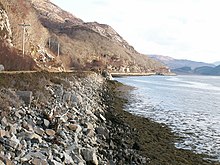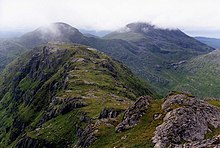Moidart
This article needs additional citations for verification. (May 2016) |
Moidart (
Moidart is currently part of the district of
Moidart forms part of the Morar, Moidart and Ardnamurchan National Scenic Area,[1] one of 40 such areas in Scotland, which are defined so as to identify areas of exceptional scenery and to ensure its protection by restricting certain forms of development.[2]
History
Early history

Following raids by
In the early 12th century,

Following the 1266
As part of the arrangement, John deprived his eldest son, Ranald, of the ability to inherit the Lordship of the Isles, in favour of a son by his new wife; as compensation, he made Ranald the Lord of Garmoran.
However, at the end of the 14th century, on Ranald's death, his sons were still children, and Ranald's younger brother Godfrey took the opportunity to seize the Lordship of Garmoran. Furthermore, the heirs of Ranald's other brother Murdoch now made their own claim. This involved Godfrey's family (the Siol Gorrie) and those of his brothers in a great deal of violent conflict which is not described in much detail in surviving records.

In 1427, frustrated with the level of violence generally in the highlands, together with the insurrection caused by
position as Lord of Garmoran, and in view of Ranald's heirs being no less responsible for the violence, King James declared the Lordship forfeit.Lairdship grants

In 1469, James' grandson (James III) granted Lairdship of the lands of Garmoran and Uist to John, the Lord of the Isles. In turn, John passed it to his own half-brother, Hugh of Sleat; the grant to Hugh was confirmed by the king in a 1493 charter. The violence that led to Alexander's execution had brought the Siol Gorrie to the brink of extinction, and after Alexander's death they played no further part in Moidart's history.[4]
Ranald's heirs (Clan Ranald) disputed and fought against the charter. Following Hugh of Sleat's death, in 1498, and for reasons that are not remotely clear, his son John immediately resigned, transferring all authority to the king. In 1532, the king granted Moidart to the leader of Clan Ranald, John Moidartach. The charter granting him the lands also acknowledged his ownership of the lands of his former uncle, Ranald Bane, who had been granted the adjacent lands of Arisaig some 30 years earlier.
In 1609, following a degree of lawlessness in the region, John's grandson Donald was imprisoned. Donald was only released on condition of being obedient to the king,
Later history

The
Unlike many other areas of Jacobite sympathy, no attempt was made to establish a military road into Moidart, and it remained without road access until the A861 was built, in 1966 (after receiving approval in 1963[5]). Prior to that, other than a rough footpath, it could only be accessed by a ferry running between Lochailort (at the north of Moidart) and Glenuig (in the west). It wasn't until 1988 that it became possible for residents to have a connection to the mains electricity supply.
The remoteness ensured the persistence both of Catholicism, despite the Scottish Reformation,[6] and of the Gaelic language. The area remained strongly Gaelic-speaking until the mid 20th century – in the 1881 census, around 90% of the population were able to speak Gaelic and over a third unable to speak English, though by 2001 the share of Gaelic speakers had declined to under 15% of habitual residents.[7]
The lack of connectivity before the 1960s also made the area an ideal training location for special operational units during
Famous people
- Jacobite
- Fergie MacDonald was raised in the area.
References
- ^ "National Scenic Areas - Maps". SNH. 20 December 2010. Archived from the original on 12 June 2018. Retrieved 14 May 2018.
- ^ "National Scenic Areas". Scottish Natural Heritage. Retrieved 14 May 2018.
- ISBN 1-84158-253-0., p. 102.
- ^ a b Gregory, Donald (1836), History of the Western Highlands and Isles of Scotland, from A.D. 1493 to A.D. 1625, with a brief introductory sketch, from A.D. 80 to A.D. 1493, Edinburgh, W. Tait, retrieved 11 May 2012, p. 65
- ^ "Tourist Road in Moidart. Approval for Gran". The Glasgow Herald. 12 April 1963. p. 1. Retrieved 26 December 2016.
- ^ Sara Maitland, "I sat alone in silence and was absorbed into the mystery of beauty", The Tablet, 10 August 2019 p. 9
- ^ Duwe, Kurt C. "Vol. 01: Àird nam Murchan & Loch Abar an Iar" (PDF). Scottish Gaelic Local Studies. Retrieved 23 April 2017.
Sources
- Rev. Charles Macdonald, Moidart, or among the Clanranalds (1889)
